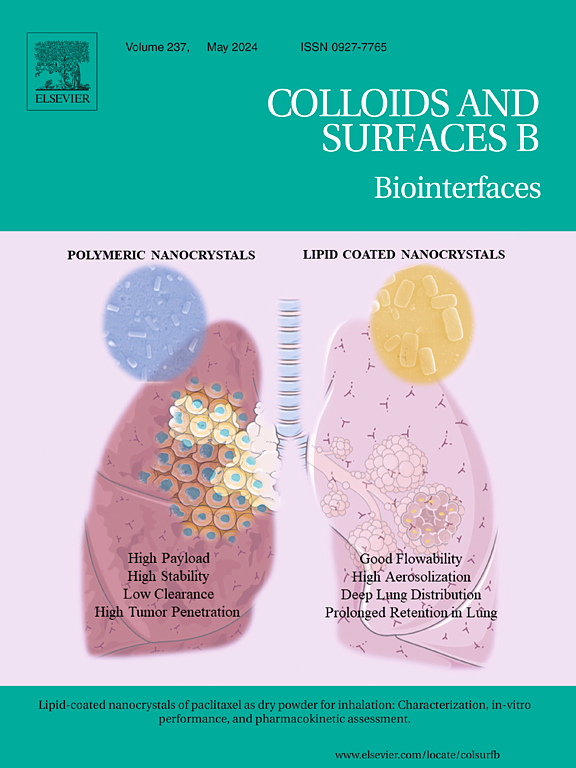青蒿琥酯碳点通过激活AMPK减轻牙周炎症和促进骨再生
IF 5.4
2区 医学
Q1 BIOPHYSICS
引用次数: 0
摘要
牙周炎被认为是一种慢性炎症,表现为持续的牙龈炎症和牙槽骨组织的逐渐退化。如果没有适当的干预,这种病理过程可能最终导致恒牙脱落。因此,牙周炎的治疗策略主要集中在减轻炎症反应和刺激骨组织再生。最近的药理学研究强调了青蒿琥酯(ART)作为一种具有显著抗炎功效的化合物,尽管其临床应用受到有限的水溶性和次优药代动力学性质的限制。碳基量子点作为一种多用途的纳米材料,展示了多种生物功能。本研究通过水热合成方法成功合成了青蒿琥酯类碳点(ACDs),并对其在牙周病模型中抑制炎症和促进骨形成的双重治疗效果进行了综合评价。实验数据显示,ACDs具有更好的亲水性,良好的生物相容性,同时具有抗炎/成骨能力。机制上,ACDs激活单磷酸腺苷活化蛋白激酶(AMPK),进而抑制活化B细胞核因子κB轻链增强子(NF-κB)信号转导,有效减少促炎细胞因子的分泌。AMPK通路激活在mRNA翻译和蛋白合成水平上进一步上调成骨分化标志物的表达模式,增强大鼠骨髓间充质干细胞(rBMSCs)的矿化能力,增加钙化结节的形成。总之,这些发现表明,ACDs有效地对抗脂多糖(LPS)诱导的炎症反应,同时通过AMPK通路调节显著改善骨再生过程。这项研究表明,ACDs是一种很有前途的基于纳米技术的牙周炎治疗方法。本文章由计算机程序翻译,如有差异,请以英文原文为准。
Artesunate carbon dots for attenuating periodontal inflammation and promoting bone regeneration via activation of AMPK
Periodontitis, recognized as a chronic inflammatory condition, manifests through sustained gingival inflammation and gradual degradation of alveolar bone tissue. Without proper intervention, this pathological process may culminate in permanent tooth detachment. Consequently, therapeutic strategies for periodontitis primarily focus on mitigating inflammatory reactions and stimulating osseous tissue regeneration. Recent pharmacological investigations have highlighted artesunate (ART) as a compound exhibiting notable anti-inflammatory efficacy, though its clinical application is constrained by limited aqueous solubility and suboptimal pharmacokinetic properties. Carbon-based quantum dots, emerging as versatile nanoscale materials, demonstrate multiple biological functionalities. This research successfully synthesized artesunate-derived carbon dots (ACDs) through hydrothermal synthesis and comprehensively evaluated their dual therapeutic effects on inflammation suppression and bone formation enhancement in periodontal disease models. Experimental data revealed that ACDs exhibit improved hydrophilicity, favorable biocompatibility, and simultaneous anti-inflammatory/osteogenic capabilities. Mechanistically, ACDs activated the adenosine monophosphate-activated protein kinase (AMPK), subsequently inhibiting nuclear factor kappa-light-chain-enhancer of activated B cells (NF-κB) signaling transduction, which effectively reduced pro-inflammatory cytokine secretion. AMPK pathway activation further upregulated expression patterns of osteogenic differentiation markers at both mRNA translation and protein synthesis levels, enhanced mineralization capacity in rat bone marrow mesenchymal stem cells (rBMSCs), and increased calcified nodule formation. Collectively, these findings demonstrate that ACDs effectively counteract lipopolysaccharide (LPS)-induced inflammatory responses while substantially improving bone regenerative processes through AMPK pathway modulation. This investigation suggests ACDs as a promising nanotechnology-based approach for periodontitis management.
求助全文
通过发布文献求助,成功后即可免费获取论文全文。
去求助
来源期刊

Colloids and Surfaces B: Biointerfaces
生物-材料科学:生物材料
CiteScore
11.10
自引率
3.40%
发文量
730
审稿时长
42 days
期刊介绍:
Colloids and Surfaces B: Biointerfaces is an international journal devoted to fundamental and applied research on colloid and interfacial phenomena in relation to systems of biological origin, having particular relevance to the medical, pharmaceutical, biotechnological, food and cosmetic fields.
Submissions that: (1) deal solely with biological phenomena and do not describe the physico-chemical or colloid-chemical background and/or mechanism of the phenomena, and (2) deal solely with colloid/interfacial phenomena and do not have appropriate biological content or relevance, are outside the scope of the journal and will not be considered for publication.
The journal publishes regular research papers, reviews, short communications and invited perspective articles, called BioInterface Perspectives. The BioInterface Perspective provide researchers the opportunity to review their own work, as well as provide insight into the work of others that inspired and influenced the author. Regular articles should have a maximum total length of 6,000 words. In addition, a (combined) maximum of 8 normal-sized figures and/or tables is allowed (so for instance 3 tables and 5 figures). For multiple-panel figures each set of two panels equates to one figure. Short communications should not exceed half of the above. It is required to give on the article cover page a short statistical summary of the article listing the total number of words and tables/figures.
 求助内容:
求助内容: 应助结果提醒方式:
应助结果提醒方式:


